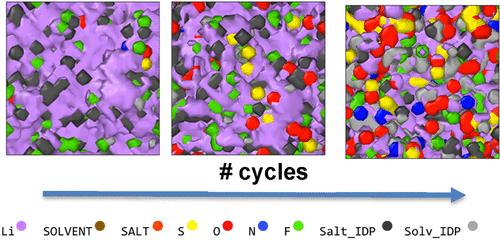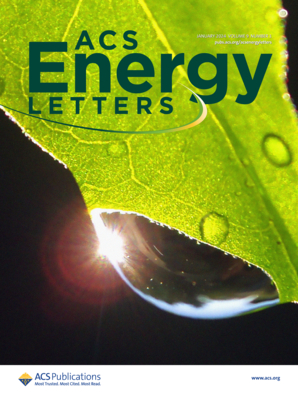SEI Formation and Lithium-Ion Electrodeposition Dynamics in Lithium Metal Batteries via First-Principles Kinetic Monte Carlo Modeling
IF 19.3
1区 材料科学
Q1 CHEMISTRY, PHYSICAL
引用次数: 0
Abstract
The stabilization and enhanced performance of lithium metal batteries (LMBs) depend on the formation and evolution of the Solid Electrolyte Interphase (SEI) layer as a critical component for regulating the Li metal electrodeposition processes. This study employs a first-principles kinetic Monte Carlo (kMC) model to simulate the SEI formation and Li+ electrodeposition processes on a lithium metal anode, integrating both the electrochemical electrolyte reduction reactions and the diffusion events giving place to the SEI aggregation processes during battery charge and discharge processes. The model replicates the competitive interactions between organic and inorganic SEI components, emphasizing the influence of the cycling regime. Results indicate that grain boundaries within the SEI facilitate faster lithium-ion transport compared to crystalline regions, crucial for improving the performance and stability of LMBs. The findings underscore the importance of dynamic SEI modeling for further development of next-generation high-energy-density batteries.

通过第一原理动力学蒙特卡洛建模研究锂金属电池中 SEI 的形成和锂离子电沉积动力学
锂金属电池(LMB)的稳定和性能提升取决于固态电解质相间层(SEI)的形成和演化,这是调节锂金属电沉积过程的关键组成部分。本研究采用第一原理动力学蒙特卡洛(kMC)模型模拟锂金属阳极上 SEI 的形成和 Li+ 的电沉积过程,同时整合了电池充放电过程中的电化学电解质还原反应和 SEI 聚集过程的扩散事件。该模型复制了有机和无机 SEI 成分之间的竞争性相互作用,强调了循环机制的影响。结果表明,与结晶区域相比,SEI 中的晶界有助于加快锂离子传输速度,这对提高 LMB 的性能和稳定性至关重要。这些发现强调了动态 SEI 建模对进一步开发新一代高能量密度电池的重要性。
本文章由计算机程序翻译,如有差异,请以英文原文为准。
求助全文
约1分钟内获得全文
求助全文
来源期刊

ACS Energy Letters
Energy-Renewable Energy, Sustainability and the Environment
CiteScore
31.20
自引率
5.00%
发文量
469
审稿时长
1 months
期刊介绍:
ACS Energy Letters is a monthly journal that publishes papers reporting new scientific advances in energy research. The journal focuses on topics that are of interest to scientists working in the fundamental and applied sciences. Rapid publication is a central criterion for acceptance, and the journal is known for its quick publication times, with an average of 4-6 weeks from submission to web publication in As Soon As Publishable format.
ACS Energy Letters is ranked as the number one journal in the Web of Science Electrochemistry category. It also ranks within the top 10 journals for Physical Chemistry, Energy & Fuels, and Nanoscience & Nanotechnology.
The journal offers several types of articles, including Letters, Energy Express, Perspectives, Reviews, Editorials, Viewpoints and Energy Focus. Additionally, authors have the option to submit videos that summarize or support the information presented in a Perspective or Review article, which can be highlighted on the journal's website. ACS Energy Letters is abstracted and indexed in Chemical Abstracts Service/SciFinder, EBSCO-summon, PubMed, Web of Science, Scopus and Portico.
 求助内容:
求助内容: 应助结果提醒方式:
应助结果提醒方式:


